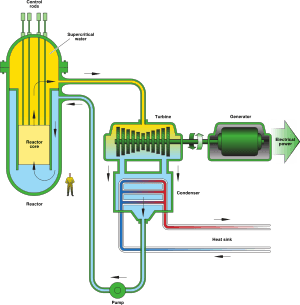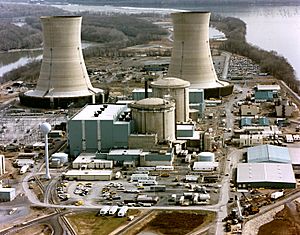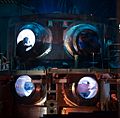Nuclear reactor facts for kids
A nuclear reactor is a special machine that creates heat using a process called nuclear fission. Think of it like a very powerful furnace! This heat is often used to make electricity.
Inside a reactor, tiny particles called atoms are split apart. This splitting releases a lot of energy as heat. The most common "fuel" for these reactors is a type of uranium called uranium-235, or plutonium-239.
In nuclear power plants, the heat from the reactor boils water. This creates steam. The steam then spins large machines called turbines. These turbines are connected to generators that produce electricity.
Some reactors are used for other things. They can make neutrons for science research. They also create special isotopes that are radioactive. These are used in medicine or other fields. Some universities even have small reactors. They help students learn how these amazing machines work.
Contents
How Nuclear Reactors Work
Nuclear reactors use a process called nuclear fission. This is when the nucleus of an atom splits into smaller parts. When an atom splits, it releases a lot of energy. It also releases more neutrons. These new neutrons can then hit other atoms. This causes them to split too. This chain reaction creates a lot of heat.
The heat from the fission process is used to boil water. This creates high-pressure steam. This steam then turns the blades of a turbine. The turbine is connected to a generator. The generator then makes electricity.
The First Nuclear Reactor
The very first nuclear reactor was built in 1942. A team of scientists led by Enrico Fermi created it. This was part of the Manhattan Project. The project needed fuel from the reactor to make the atomic bomb.
The first nuclear reactor to make electricity was built in Idaho in 1951. It was a small experiment. It only made enough electricity to power four light bulbs!
Safety and Challenges
Building nuclear reactors is very expensive. This is because they need many safety features. These features help prevent accidents. There is also a challenge with the waste they produce. This waste is radioactive and must be stored safely for a very long time.
However, nuclear reactors produce electricity cheaply. They also do not pollute the air with smoke or greenhouse gases.
There have been some serious accidents at nuclear reactors. These include:
- Windscale in the UK in 1957.
- Mayak in the USSR in 1957.
- Three Mile Island in the USA in 1979.
- Chernobyl in the USSR in 1986.
- Fukushima in Japan in 2011.
Concerns about safety have slowed down the growth of nuclear power. Today, there are about 437 reactors worldwide. They provide about 5% of the world's electricity.
Images for kids
-
The Chicago Pile, the first nuclear reactor, built in secrecy at the University of Chicago in 1942 during World War II as part of the US's Manhattan project
-
Lise Meitner and Otto Hahn in their laboratory
-
Some of the Chicago Pile Team, including Enrico Fermi and Leó Szilárd
-
Primary coolant system showing reactor pressure vessel (red), steam generators (purple), pressurizer (blue), and pumps (green) in the three coolant loop Hualong One pressurized water reactor design
-
NC State's PULSTAR Reactor is a 1 MW pool-type research reactor with 4% enriched, pin-type fuel consisting of UO2 pellets in zircaloy cladding.
-
The Magnox Sizewell A nuclear power station
-
Three of the reactors at Fukushima I overheated, causing the coolant water to dissociate and led to the hydrogen explosions. This along with fuel meltdowns released large amounts of radioactive material into the air.
See also
 In Spanish: Reactor nuclear para niños
In Spanish: Reactor nuclear para niños


















